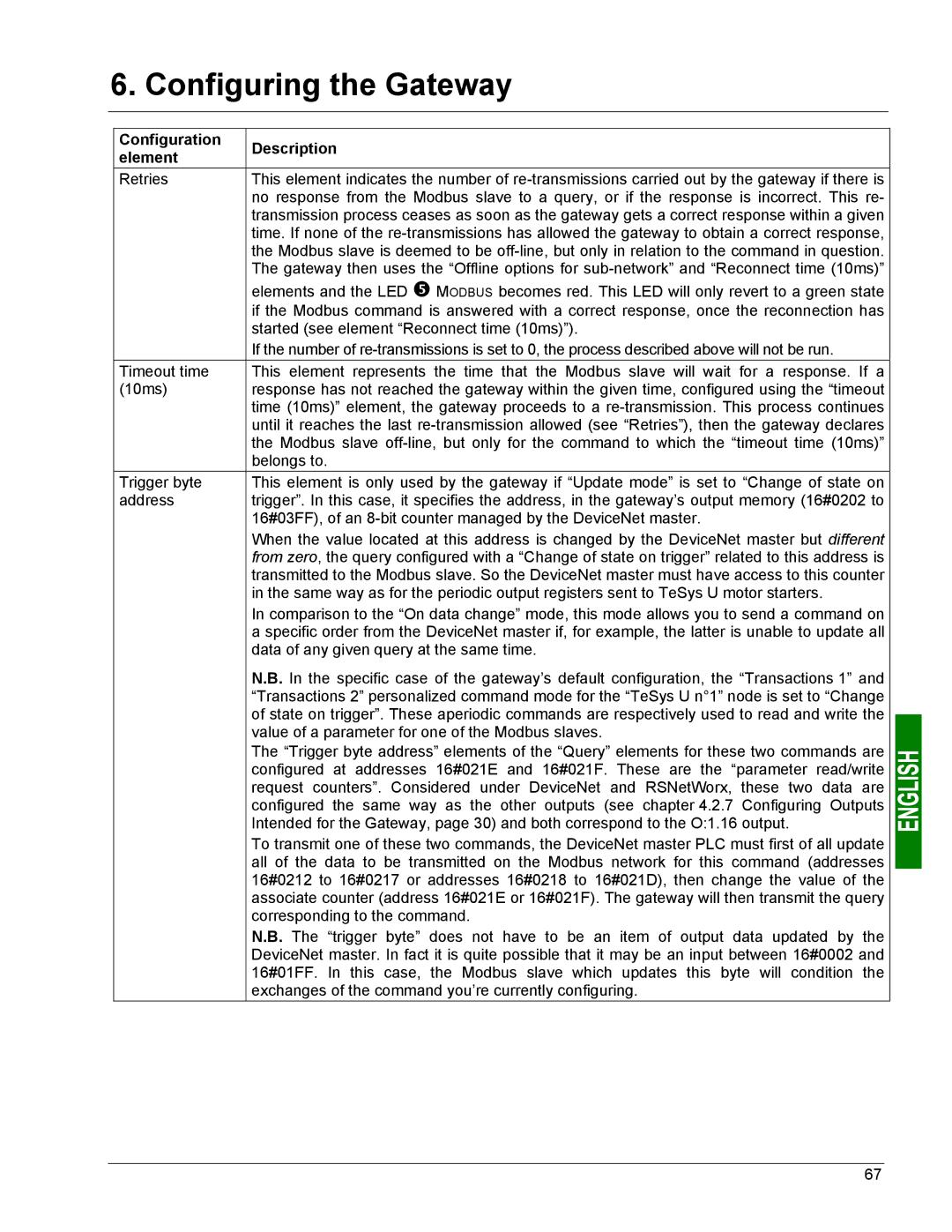
6. Configuring the Gateway
Configuration | Description | |
element | ||
| ||
Retries | This element indicates the number of | |
| no response from the Modbus slave to a query, or if the response is incorrect. This re- | |
| transmission process ceases as soon as the gateway gets a correct response within a given | |
| time. If none of the | |
| the Modbus slave is deemed to be | |
| The gateway then uses the “Offline options for | |
| elements and the LED r MODBUS becomes red. This LED will only revert to a green state | |
| if the Modbus command is answered with a correct response, once the reconnection has | |
| started (see element “Reconnect time (10ms)”). | |
| If the number of | |
Timeout time | This element represents the time that the Modbus slave will wait for a response. If a | |
(10ms) | response has not reached the gateway within the given time, configured using the “timeout | |
| time (10ms)” element, the gateway proceeds to a | |
| until it reaches the last | |
| the Modbus slave | |
| belongs to. | |
Trigger byte | This element is only used by the gateway if “Update mode” is set to “Change of state on | |
address | trigger”. In this case, it specifies the address, in the gateway’s output memory (16#0202 to | |
| 16#03FF), of an | |
| When the value located at this address is changed by the DeviceNet master but different | |
| from zero, the query configured with a “Change of state on trigger” related to this address is | |
| transmitted to the Modbus slave. So the DeviceNet master must have access to this counter | |
| in the same way as for the periodic output registers sent to TeSys U motor starters. | |
| In comparison to the “On data change” mode, this mode allows you to send a command on | |
| a specific order from the DeviceNet master if, for example, the latter is unable to update all | |
| data of any given query at the same time. | |
| N.B. In the specific case of the gateway’s default configuration, the “Transactions 1” and | |
| “Transactions 2” personalized command mode for the “TeSys U n°1” node is set to “Change | |
| of state on trigger”. These aperiodic commands are respectively used to read and write the | |
| value of a parameter for one of the Modbus slaves. | |
| The “Trigger byte address” elements of the “Query” elements for these two commands are | |
| configured at addresses 16#021E and 16#021F. These are the “parameter read/write | |
| request counters”. Considered under DeviceNet and RSNetWorx, these two data are | |
| configured the same way as the other outputs (see chapter 4.2.7 Configuring Outputs | |
| Intended for the Gateway, page 30) and both correspond to the O:1.16 output. | |
| To transmit one of these two commands, the DeviceNet master PLC must first of all update | |
| all of the data to be transmitted on the Modbus network for this command (addresses | |
| 16#0212 to 16#0217 or addresses 16#0218 to 16#021D), then change the value of the | |
| associate counter (address 16#021E or 16#021F). The gateway will then transmit the query | |
| corresponding to the command. | |
| N.B. The “trigger byte” does not have to be an item of output data updated by the | |
| DeviceNet master. In fact it is quite possible that it may be an input between 16#0002 and | |
| 16#01FF. In this case, the Modbus slave which updates this byte will condition the | |
| exchanges of the command you’re currently configuring. |
67
